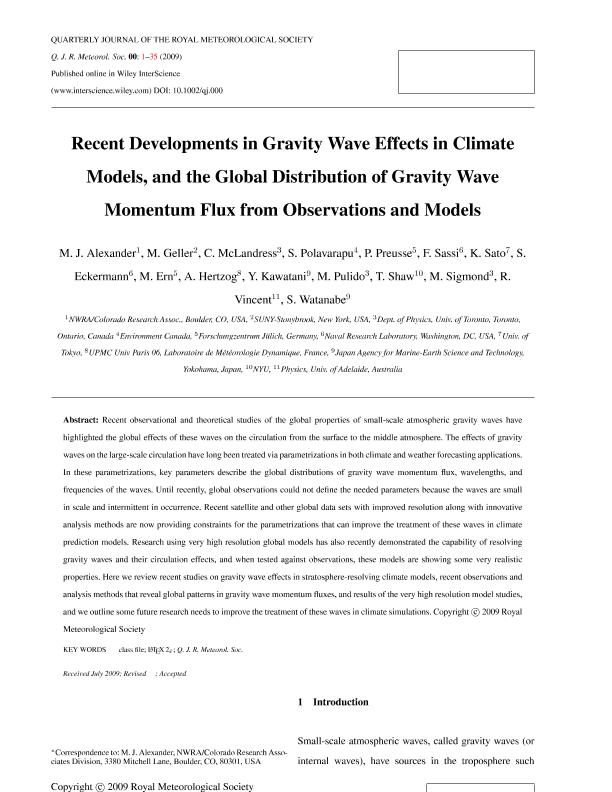Mostrar el registro sencillo del ítem
dc.contributor.author
Alexander, M. J.
dc.contributor.author
Geller, M.
dc.contributor.author
McLandress, C.
dc.contributor.author
Polavarapu, S.
dc.contributor.author
Preusse, P.
dc.contributor.author
Sassi, F.
dc.contributor.author
Sato, K.
dc.contributor.author
Eckermann, S.
dc.contributor.author
Ern, M.
dc.contributor.author
Hertzog, A.
dc.contributor.author
Kawatani, Y.
dc.contributor.author
Pulido, Manuel Arturo

dc.contributor.author
Shaw, T.
dc.contributor.author
Sigmond, M.
dc.contributor.author
Vincent, R.
dc.contributor.author
Watanabe, S.
dc.date.available
2017-05-26T18:57:05Z
dc.date.issued
2010-07
dc.identifier.citation
Alexander, M. J.; Geller, M.; McLandress, C.; Polavarapu, S.; Preusse, P.; et al.; Recent developments in gravity wave effects in climate models, and the global distribution of gravity wave momentum flux from observations and models; John Wiley & Sons Ltd; Quarterly Journal Of The Royal Meteorological Society; 136; 650; 7-2010; 1103-1124
dc.identifier.issn
0035-9009
dc.identifier.uri
http://hdl.handle.net/11336/16993
dc.description.abstract
Recent observational and theoretical studies of the global properties of small-scale atmospheric gravity waves have highlighted the global effects of these waves on the circulation from the surface to the middle atmosphere. The effects of gravity waves on the large-scale circulation have long been treated via parametrizations in both climate and weather forecasting applications. In these parametrizations, key parameters describe the global distributions of gravity wave momentum flux, wavelengths, and frequencies of the waves. Until recently, global observations could not define the needed parameters because the waves are small in scale and intermittent in occurrence. Recent satellite and other global data sets with improved resolution along with innovative analysis methods are now providing constraints for the parametrizations that can improve the treatment of these waves in climate prediction models. Research using very high resolution global models has also recently demonstrated the capability of resolving gravity waves and their circulation effects, and when tested against observations, these models are showing some very realistic properties. Here we review recent studies on gravity wave effects in stratosphere-resolving climate models, recent observations and analysis methods that reveal global patterns in gravity wave momentum fluxes, and results of the very high resolution model studies, and we outline some future research needs to improve the treatment of these waves in climate simulations.
dc.format
application/pdf
dc.language.iso
eng
dc.publisher
John Wiley & Sons Ltd

dc.rights
info:eu-repo/semantics/openAccess
dc.rights.uri
https://creativecommons.org/licenses/by-nc-sa/2.5/ar/
dc.subject
Missing Force
dc.subject
Climate Models
dc.subject
Atmosphere
dc.subject
Gravity Wave
dc.subject
Momentum Flux
dc.subject
Drag
dc.subject
Wind Tendency
dc.subject
Global Model
dc.subject.classification
Meteorología y Ciencias Atmosféricas

dc.subject.classification
Ciencias de la Tierra y relacionadas con el Medio Ambiente

dc.subject.classification
CIENCIAS NATURALES Y EXACTAS

dc.title
Recent developments in gravity wave effects in climate models, and the global distribution of gravity wave momentum flux from observations and models
dc.type
info:eu-repo/semantics/article
dc.type
info:ar-repo/semantics/artículo
dc.type
info:eu-repo/semantics/publishedVersion
dc.date.updated
2017-05-17T13:46:57Z
dc.identifier.eissn
1477-870X
dc.journal.volume
136
dc.journal.number
650
dc.journal.pagination
1103-1124
dc.journal.pais
Reino Unido

dc.journal.ciudad
Reading
dc.description.fil
Fil: Alexander, M. J.. NWRA/Colorado Research Association; Estados Unidos
dc.description.fil
Fil: Geller, M.. SUNY-Stonybrook; Estados Unidos
dc.description.fil
Fil: McLandress, C.. University of Toronto; Canadá
dc.description.fil
Fil: Polavarapu, S.. Environment; Canadá
dc.description.fil
Fil: Preusse, P.. Forschungzentrum Jülich; Alemania
dc.description.fil
Fil: Sassi, F.. Naval Research Laboratory; Estados Unidos
dc.description.fil
Fil: Sato, K.. University of Tokyo; Japón
dc.description.fil
Fil: Eckermann, S.. Naval Research Laboratory; Estados Unidos
dc.description.fil
Fil: Ern, M.. Forschungzentrum Jülich; Alemania
dc.description.fil
Fil: Hertzog, A.. UPMC Université Paris 06. Laboratoire de Météorologie Dynamique; Francia
dc.description.fil
Fil: Kawatani, Y.. Japan Agency for Marine-Earth Science and Technology; Japón
dc.description.fil
Fil: Pulido, Manuel Arturo. Consejo Nacional de Investigaciones Científicas y Técnicas. Centro Científico Tecnológico Conicet - Nordeste. Instituto de Modelado e Innovación Tecnológica. Universidad Nacional del Nordeste. Facultad de Ciencias Exactas Naturales y Agrimensura. Instituto de Modelado e Innovación Tecnologica; Argentina
dc.description.fil
Fil: Shaw, T.. New York University; Estados Unidos
dc.description.fil
Fil: Sigmond, M.. University of Toronto; Canadá
dc.description.fil
Fil: Vincent, R.. University of Adelaide; Australia
dc.description.fil
Fil: Watanabe, S.. Japan Agency for Marine-Earth Science and Technology; Japón
dc.journal.title
Quarterly Journal Of The Royal Meteorological Society

dc.relation.alternativeid
info:eu-repo/semantics/altIdentifier/url/http://onlinelibrary.wiley.com/doi/10.1002/qj.637/abstract
dc.relation.alternativeid
info:eu-repo/semantics/altIdentifier/doi/http://dx.doi.org/10.1002/qj.637
Archivos asociados
